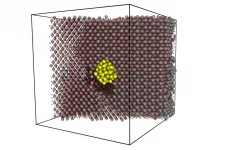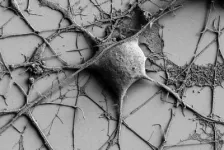An improved safety standard for bionic devices
Australian scientists have developed a new moisture test for pacemakers and cochlear implants
2021-03-29
(Press-News.org) Applied physicists at the University of Sydney have proposed new standards to measure moisture leaks into bionic devices such as pacemakers, cochlear hearing implants and retinal replacements.
The researchers, who received an industry partnership funding through the Australian Research Council to undertake the study, say the new moisture standards could give the wearers of bionic implants extra confidence in the operation of the life-changing devices. They also say that the improved moisture-testing regime could be used in the emerging renewable energy industry where new-generation solar cells require high standards of humidity control.
Bionic implants must be able to operate successfully in moist environments in the human body. While the potential for large leaks into the devices are easy to detect during manufacturing, small leaks can escape detection and standard testing is required to ensure safety and prevent moisture-induced failure.
Professor David McKenzie from the School of Physics at the University of Sydney said: "The accurate measurement of moisture penetration into medical devices is essential to guarantee long-term performance. Accurate measurement needs an accurate industry standard to assess leak risks."
He said there are commercially available systems that measure relative humidity, but these are not sensitive enough for the most demanding applications in implantable biomedical devices. Using mass spectroscopy technology, the measurement of helium as a proxy for moisture leakage is a de facto industry standard test for the critical small leaks that are hard to pick up.
In practice and in most cases, helium testing of bionic devices is a good standard, but by improving the compliance by a factor of 10, we think the industry can further guarantee the safety of biomedical implants," Professor McKenzie said.
"Helium leak detection tests are widely used for the location of more sensitive leaks, but direct measurement of gaseous or liquid water leakage at similar sensitivities has proven too difficult until now," he said.
Professor McKenzie and colleagues from the Australian government's National Measurement Institute and have developed a standard leak test and shown how to use it to verify the quality of encapsulations, or the containment of medical devices.
They have published their research in the American Chemical Society's Applied Materials & Interfaces.
Lead author Dr Wenwen Lei from the National Measurement Institute said: "For very high sensitivities, it is important we try to directly measure water leak risks rather than the de facto measure of helium, which is not as accurate.
"Water has special abilities to penetrate through very small spaces given its different behaviour. For instance, it has been recently discovered that water acts in a really weird way in carbon nanotubes, where the water does not seem to touch the sides of tiny passageways not much wider than a millionth of a human hair."
Professor McKenzie said: "Any such 'nanoleakage' would be really serious if it happened in medical devices, especially those with lots of feedthrough apertures, such as the bionic eye."
The new standard moisture leak breaks new ground by studying water behaviour in a stable polymer material. Using the new tests, researchers directly compared water leakage to helium leakage in biomedical test structures. They found that in the majority of cases, calibrated measurements of moisture leak rates do exceed helium leak rates, especially for very small and large leaks.
Given their findings that water can leak up to 10 times the rate of helium leaks, they propose strengthening the compliance standard for helium testing of biomedical devices tenfold, or one order of magnitude.
"As we improve bionic technology, wearable implants will become more common, so it's important to give people that extra level of safety assurance," Professor McKenzie said.
INFORMATION:
INTERVIEWS
Professor David McKenzie | david.mckenzie@sydney.edu.au
Dr Wenwen Lei | wenwen.lei@measurement.gov.au
MEDIA ENQUIRIES
Marcus Strom | marcus.strom@sydney.edu.au | +61 423 982 485
DECLARATION
The Australian Government is acknowledged for support through Australian Research Council Linkage grants LP 0776813 and LP110200227. Cochlear Limited is acknowledged for in-kind contributions and financial support through the ARC Linkage grant program.
ELSE PRESS RELEASES FROM THIS DATE:
2021-03-29
Scientists reported new research results today suggesting that artificial objects in orbit around the Earth are brightening night skies on our planet significantly more than previously understood.
The research, accepted for publication in Monthly Notices of the Royal Astronomical Society: Letters, finds that the number of objects orbiting Earth could elevate the overall brightness of the night sky by more than 10 percent above natural light levels across a large part of the planet. This would exceed a threshold that astronomers set over 40 years ago for considering a location "light polluted".
"Our primary motivation was to estimate the potential contribution to night sky brightness from external sources, such ...
2021-03-29
A team of scientists led by Nanyang Technological University, Singapore (NTU Singapore) has developed a diagnostic test that can detect the virus that causes COVID-19 even after it has gone through mutations.
Called the VaNGuard (Variant Nucleotide Guard) test, it makes use of a gene-editing tool known as CRISPR, which is used widely in scientific research to alter DNA sequences and modify gene function in human cells under lab conditions, and more recently, in diagnostic applications.
Since viruses have the ability to evolve over time, a diagnostic test robust against potential mutations ...
2021-03-29
Scientists at MIPT have found a possible explanation for the anomalously fast release of gas from nuclear fuel. Supercomputer simulations have uncovered an unexpected mechanism for accelerating the escape of gas bubbles from the uranium dioxide crystal matrix to the surface. The result points the way to eliminate the paradoxical discrepancy of several orders of magnitude between existing theoretical models and experimental results. The paper was published in the Journal of Nuclear Materials.
The diffusion of gas bubbles during reactor operation is one of the important topics in nuclear power relating to radiation safety. Bubbles of gaseous fission products (mainly xenon), accumulating in the fuel, affect many of its properties. Therefore, it is important, ...
2021-03-29
Researchers at the University of Southampton have developed a new way of using nanomaterials to identify and enrich skeletal stem cells - a discovery which could eventually lead to new treatments for major bone fractures and the repair of lost or damaged bone.
Working together, a team of physicists, chemists and tissue engineering experts used specially designed gold nanoparticles to 'seek out' specific human bone stem cells - creating a fluorescent glow to reveal their presence among other types of cells and allow them to be isolated or 'enriched'.
The researchers concluded their new technique is simpler and quicker than other methods and up to 50-500 times more effective at enriching stem cells.
The study, led by Professor ...
2021-03-29
The vast majority of the world's largest meat and dairy companies have not made an explicit commitment to achieving net-zero emissions by 2050, finds a new analysis by researchers at New York University.
The study, which appears in the journal Climatic Change, examines the climate impacts of the biggest 35 largest meat and dairy companies around the globe as well as their influence in shaping political responses to climate change.
It is the first peer-reviewed study to assess climate responsibilities of the largest meat and dairy companies.
"Large meat and dairy companies are not doing enough to tackle climate change, and countries are not doing enough in terms of holding them accountable," says Jennifer ...
2021-03-29
Research into the flower preferences of pollinating moths may have delivered a vital clue to the simple factors needed for the emergence of new species.
Strong coevolutionary relationships between plants and animal pollinators have long been recognised as a potential driver of high rates of speciation in the 275,000 extant flowering plants.
Shifts between pollinators, such as bumblebees, hummingbirds, hawkmoths and bats, often coincide with plant speciation events.
Each of these pollinator "guilds" is attracted by a different set of floral traits such as colour, patterns, scent, shape, and nectar reward, collectively known as a pollination ...
2021-03-29
UNIVERSITY PARK, Pa. -- Why do some people with cold sores around their lips experience painful lesions, while others have no symptoms at all, yet still spread the virus? A new study conducted at Penn State finds that these differences could be due to variations in the way certain strains of herpes simplex (HSV-1) -- the virus that causes cold sores, as well as genital herpes -- activate gene expression in neurons.
"HSV-1 occurs in more than half the global population," said Moriah Szpara, associate professor of biology and biochemistry and molecular biology. "Not only does it cause recurrent problems, such as cold sores ...
2021-03-29
Transition metal perovskites oxides exhibit several desirable properties, including high-temperature superconductivity and electrocatalysis. Now, scientists at Tokyo Institute of Technology explore the structure and properties of a perovskite oxide, PbFeO3, in anticipation of the unusual charge distribution and exotic magnetic transitions displayed by such systems. They report two of the magnetic transitions, with a distinctive transition above room temperature and look into its causes, opening doors to potential applications in realizing new spintronic devices.
The advent of electronics has revolutionized our lives to an extent where it is impossible to imagine going about our day without relying on an electronic device in some form. What is even more remarkable, ...
2021-03-29
In a new publication from Cardiovascular Innovations and Applications; DOI https://doi.org/10.15212/CVIA.2021.0008, Zeyi Cheng, Miaomiao Qi, Chengyuan Zhang and Yanxia Mao from Sichuan University, Sichuan, China, Second Hospital of Lanzhou University, Lanzhou, China and The Second Medical School of Lanzhou University, Lanzhou, China consider myocardial fibrosis in the pathogenesis, diagnosis, and treatment of hypertrophic cardiomyopathy.
The authors review the application of myocardial fibrosis in the diagnosis and treatment of HCM, focusing on research progress and the application ...
2021-03-29
In a new publication from Cardiovascular Innovations and Applications; DOI https://doi.org/10.15212/CVIA.2021.0007, Sharen Lee and Gary Tse from Laboratory of Cardiovascular Physiology, Hong Kong, HKG, China, Second Hospital of Tianjin Medical University, Tianjin, China and Xiamen Cardiovascular Hospital, Xiamen, China consider a case of atezolizumab-induced autoimmune diabetes mellitus presenting with diabetic ketoacidosis.
Atezolizumab, an immune checkpoint inhibitor, is a humanized monoclonal, anti-programmed death ligand 1 (PD-L1) antibody used for the treatment of metastatic urothelial carcinoma that has progressed after chemotherapy. PD-L1 inhibitors can induce type 1 diabetes, and patients can present with diabetic ketoacidosis. ...
LAST 30 PRESS RELEASES:
[Press-News.org] An improved safety standard for bionic devices
Australian scientists have developed a new moisture test for pacemakers and cochlear implants




